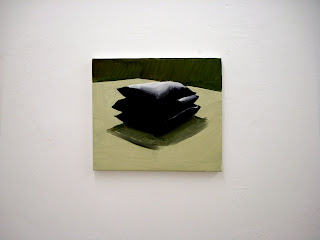
STAATLICHE KUNSTSAMMLUNG DRESDEN
Residenzschloss
August 3–September 30
The architecture of German cities registers the passage of time and the impact of sociopolitical upheaval more acutely and literally than almost any other European context. A dynamic admixture of selective preservation, radical reconstruction, and elegant decay endows cities like Berlin and Dresden with an archaeological character that is as politically charged as it is riveting. Within this context, German artist Markus Draper’s multimedia work is unusually attuned to the way architectural sites can register, preserve, and help us come to grips with the deep social trauma that is a central part of Germany’s recent history. The centerpiece of this show is Draper’s room-size installation Skulpturenkino: House of Darkness (all works 2006). Inside a simply constructed wood and particleboard building is a DVD projection that shows a maquette-size version of the installation, bleeding and shaking violently while a deep voice intones “This is the house of blood” in German. Though Draper’s disconcerting splatter-horror installation is ostensibly based on the House of Horrors in Gloucestershire, England, where Fred and Rose West tortured, killed, and buried young girls, the work operates more broadly as a meditation on the way inanimate objects become emblematic of historical episodes and restage those events for visitors and viewers. Working in the aftermath of National Socialism and the fall of the Berlin Wall, Draper demonstrates a keen, deeply self-critical awareness of his country’s history and uses his multimedia practice as a way to interrogate that inheritance, adopting architecture and the landscape as his principle iconographic motifs. Like House of Darkness, paintings such as Überleben im Chaos (Surviving in Chaos) and Berliner Hütte (Berlin House) represent a profound, unflinching consideration of what it means to emerge from a period of historical trauma. More important, the exhibition advances a politically productive, historically conscious idea of how to face the past lucidly and ultimately reimagine a new sense of national belonging.
—Christopher Bedford































